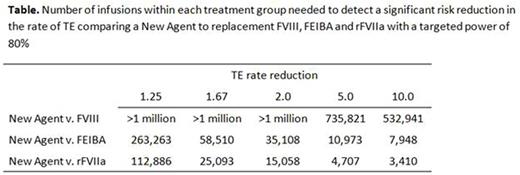Abstract
Background:In hemophilia patients with inhibitors, the primary safety concern associated with the administration of bypassing agents, such arecombinant factor VIIa (rFVIIa)andFactor Eight Inhibitor Bypass Activity (FEIBA)to manage bleeding episodes is the risk ofthromboembolic events (TEs). Replacement FVIII may also increase TEs in patients with hemophilia without inhibitors, although the incidence of TE is extremely rare. The low incidence of hemophilia and low rate of TE associated with current therapies in these patients provide a significant challenge to study the comparative safety of novel non-factor therapies with the current standard of care.
Aims: We aimed to estimate the sample size needed to adequately power a clinical trial that would detect a reduction in TEs in hemophilia patients exposed to a hypothetical investigational agent compared to current therapies for the management of bleeding episodes (FVIII replacement, FEIBA and rFVIIa).
Methods: We conducted a simulated power analysis to quantify the number of infusions that would be needed in each treatment arm (investigational therapy vs. current therapy) to detect a reduction in the rate of TE in hemophilia patients across a range of effects. Based on published data, the rate of TE was 2 per 106 infusions of replacement FVIII. We assumed conservative rates of TE of 2 per 105 infusions of replacement FVIII to account for the potential imprecise rates estimated from the low number of events observed in prior studies. In the MedWatch database, the rate of TE was 8.24 per 105 infusions of FEIBA and 24.6 per 105 infusions of NOVOSEVEN. To account for the known underreporting of adverse events in this database, we assumed conservative estimates of and, 1.34 per 103 infusions of FEIBA and 3.12 per 103 infusions of NOVOSEVEN. We applied a two-sided Z test with pooled variance and targeted the significance level of the test at 0.05 and the power at 0.8.
Results: The number of infusions needed to detect a significant reduction TE rate in patients exposed to the investigational agent compared to all 3 standard of care therapies across a range of potential effects are provided in the Table. Sample sizes of 735,821 infusions per treatment group (replacement FVIII vs. investigational agent) are needed to achieve 80% power to detect a 5 fold reduction in the rate of TE among hemophilia patients exposed to the investigational agent compared to replacement FVIII. Over 1 million infusions per treatment group would be needed to detect a 2 fold reduction in rate of TE comparing an investigational agent to replacement FVIII. Sample sizes of 35,108 infusions in each treatment group would be required to detect a 2-fold decrease in TE rates in patients exposed to the investigational agent compared to FEIBA. To detect a 2 fold reduction in rate of TE in patients receiving the investigational agent compared to rFVIIa, the study would require 15,058 infusions in each treatment group.
Conclusions: Current therapies to manage bleeding episodes in patients with hemophilia have demonstrated a high degree of safety.Clinical trials of alternative non-factor therapies with mechanisms of action that differ from the standard of care will require extremely large samples sizes and/or large reduction in TE risk to demonstrate significantly greater safety with respect to TE.
Chiuve:Shire: Employment. Gallo:Shire: Employment. Rowan:Baxalta: Consultancy. Valentino:Shire: Employment.
Author notes
Asterisk with author names denotes non-ASH members.


This feature is available to Subscribers Only
Sign In or Create an Account Close Modal